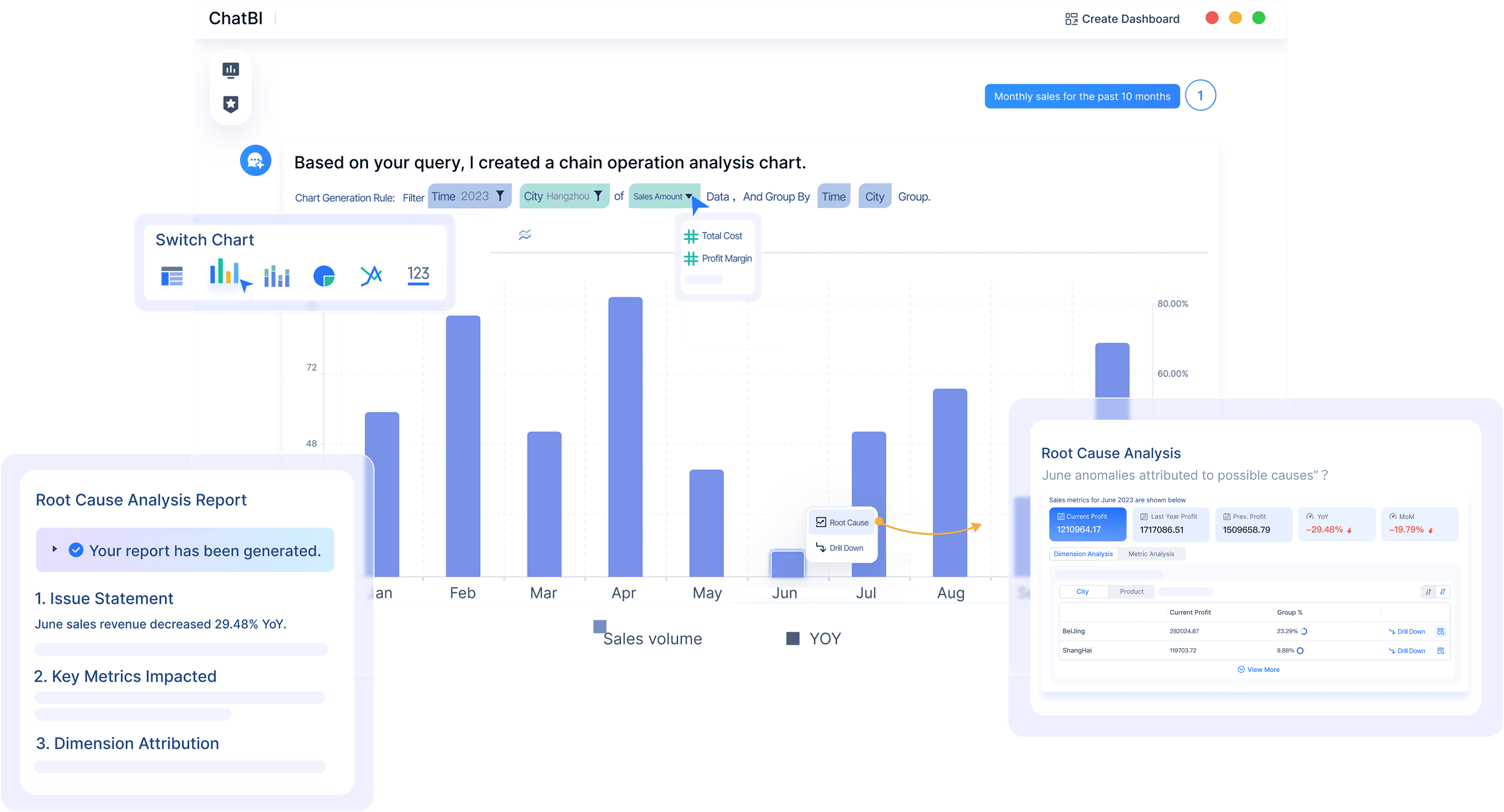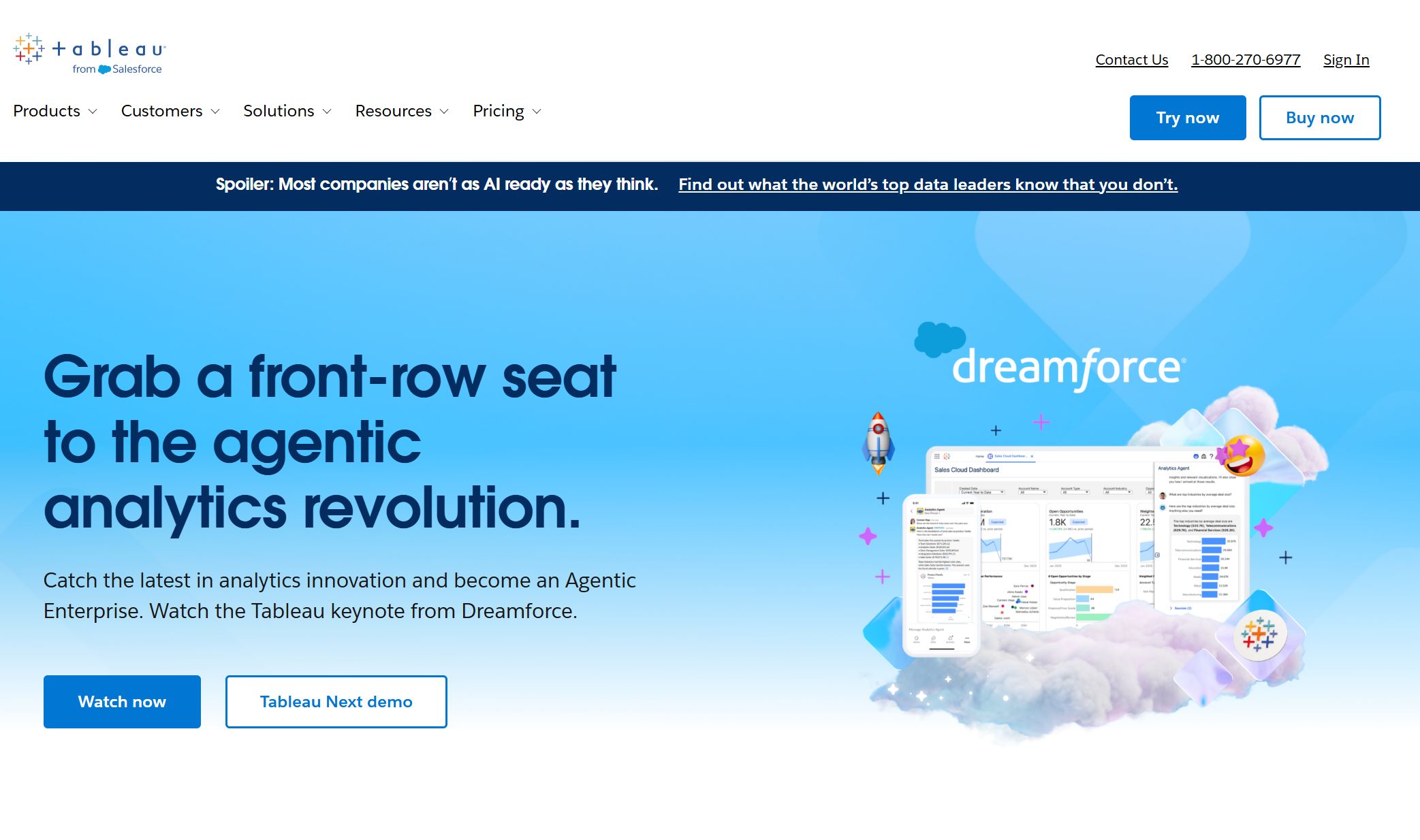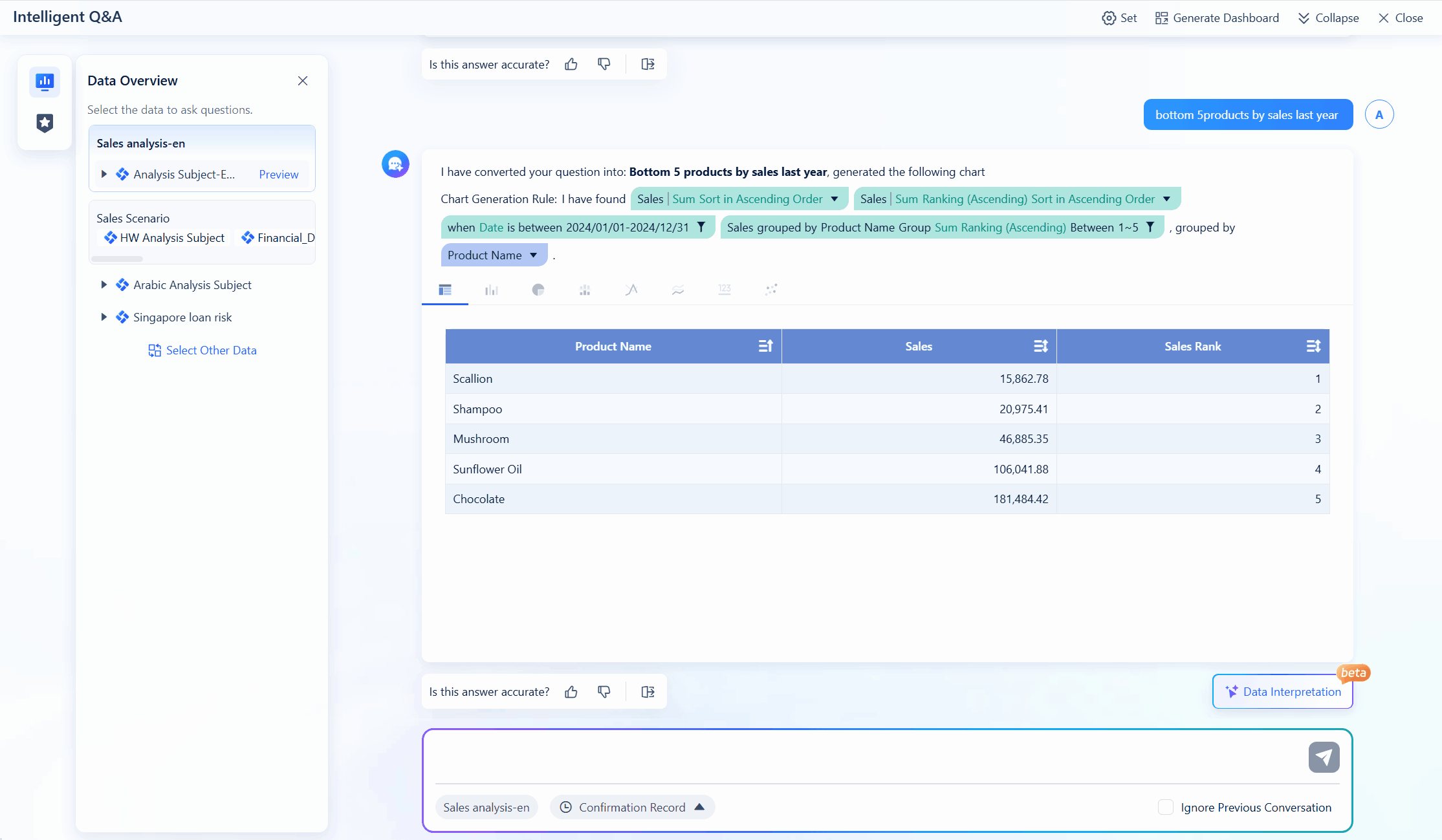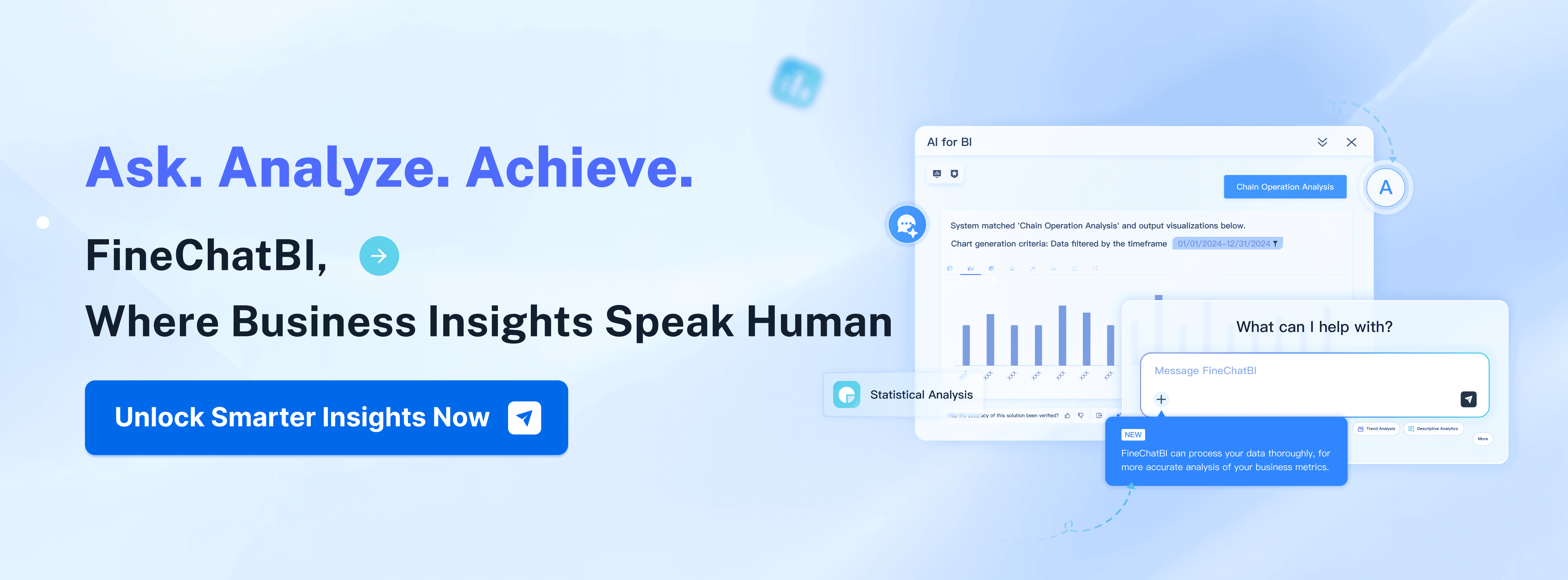If you want the best ai for analyzing data in 2025, you have plenty of options. AI now powers everything from conversational BI tools to advanced machine learning platforms. You can get real-time insights and boost productivity by up to 80%. Automation helps you focus on strategic work instead of repetitive tasks. Many businesses use these tools to adapt quickly and make smarter decisions. FanRuan stands out with innovative products like FineChatBI, which make data analysis simple and reliable.
Best AI Tools for Analyzing Data in 2025

Overview of Leading Data Analysis Tools
You have more choices than ever when it comes to picking the best ai for analyzing data. In 2025, the market is full of tools that help you turn raw data into clear insights. Some tools focus on making data analysis easy for everyone, while others offer advanced features for experts. You can find solutions that use conversational ai, automate reporting, or even predict trends before they happen. FanRuan’s FineChatBI stand out for their conversational approach, letting you ask questions in plain language and get answers you can trust. Microsoft Power BI, Tableau, and DataRobot are also popular for their strong analytics and user-friendly design. If you want to explore even more, tools like GWI Spark, Quantilope, and Brandwatch are gaining attention for their unique features.
Here’s a quick look at what sets some of the best ai for analyzing data apart:
| Tool | Main Differentiators | Pros |
|---|---|---|
| Domo | End-to-end platform, customizable data apps | AI tools, easy interface, built-in analytics |
| Microsoft Power BI | Works well with Microsoft Office, strong visualizations | Great for Microsoft users, handles big data |
| Tableau | Advanced visualizations, intuitive AI insights | Powerful visuals, easy to use |
| Polymer | Automated analysis, simple interface | Focus on automation, easy for beginners |
Quick List of Recommended AI Tools
If you want a fast list of the best ai for analyzing data, start here:
- FineChatBI by FanRuan: Conversational BI for reliable, transparent results.
- Microsoft Power BI: Seamless with Microsoft 365, AI-driven Copilot.
- Tableau with Tableau AI/Pulse: Automated insights for everyone.
- DataRobot: Automates machine learning for enterprise needs.
- GWI Spark, Quantilope, Brandwatch, Morning Consult, Browse AI, Zappi, Hotjar, Appen, YouScan, Crayon, Perplexity AI, SurveyMonkey Genius, Speak AI, Market Insights AI, ChatGPT: Each brings something special to the table.
You can find the best ai for analyzing data for any business size or skill level. Whether you want simple dashboards or advanced machine learning, there’s a tool that fits your needs.
What Makes Data Analytics Tools Effective?
Choosing the right data analytics tools can make a huge difference in how you use business intelligence. You want tools that help you turn raw data into clear, actionable insights. But what really sets the best ai tools apart? Let’s break it down.
Key Features for AI Data Analysis
When you look for effective ai tools, focus on features that make your job easier and your results more reliable. Here’s a quick table to show what matters most:
| Feature | Description |
|---|---|
| Automated Data Processing | Cleans and organizes your data automatically, saving you hours of work. |
| AI-Powered Analysis | Uses machine learning and natural language processing to spot trends fast. |
| Insight Visualization | Turns complex results into easy-to-read dashboards and charts. |
These features help you get from raw data to smart decisions without needing to be a tech expert. You can ask questions, get answers, and see the story behind your numbers.
Performance and Scalability
You need data analytics tools that keep up as your business grows. Performance and scalability matter, especially when you deal with lots of data. Here’s what to look for:
- Fast data processing, even with huge datasets.
- Real-time analytics and smart reporting that update as new data comes in.
- Automation for tasks like cleaning, integration, and anomaly detection.

Some ai tools, like Kyvos and ThoughtSpot, are built for massive scalability. They let you analyze big data quickly and get instant insights, which is key for modern business intelligence.
Integration and Usability
Great business intelligence tools fit right into your existing systems. You want easy connections to your CRM, cloud apps, and databases. Here’s a table showing how top ai tools handle integration:
| AI Tool | Integration Capabilities |
|---|---|
| Microsoft Power BI | Natural language Q&A, pattern recognition, connects with Microsoft 365 |
| Tableau with Einstein Discovery | Combines visualization with Salesforce AI for automated analysis |
| Google Cloud AI Platform | Pre-built APIs for quick integration into your apps |
| IBM Watson Studio | Collaborative notebooks, strong governance features |
Easy integration means you spend less time setting up and more time using your data. User-friendly dashboards and simple interfaces also help everyone in your team make the most of business intelligence.
In-Depth Reviews of Top AI Data Analysis Tools
FineChatBI by FanRuan
You want a conversational approach to analytics? FineChatBI by FanRuan gives you just that. This tool lets you ask questions in plain language and get reliable answers, making data analysis feel as easy as chatting with a colleague. FineChatBI combines rule-based and large models, so you get both precision and transparency. You can connect to multiple data sources, build visualizations, and even check how the system interprets your queries. With features like Text2DSL, you always know your data analysis is accurate. FineChatBI stands out for its enterprise-level business intelligence capabilities and its focus on trustworthy, ai-powered business intelligence.

Website: https://www.fanruan.com/en/finebi
Azure Machine Learning Studio
Azure Machine Learning Studio gives you a flexible environment for building and deploying machine learning models. You can use its interactive designer GUI or jump into Jupyter notebooks for custom work. The platform supports automated machine learning, so you can optimize models without deep coding skills. Here’s a quick look at its main features:
| Feature | Description |
|---|---|
| Compute | Choose from on-demand instances or clusters for different workloads. |
| Datastores | Mount data from Azure Storage for easy access and manipulation. |
| Notebooks | Integrate with Jupyter and R Studio for collaboration and custom environments. |
| Designer GUI | Build models with a drag-and-drop interface and prebuilt modules. |
| Automated ML | Run automated experiments to boost performance metrics. |
| Pricing | Pay based on compute resources; instances are usually more affordable than clusters. |

Website: https://azure.microsoft.com/en-us/products/machine-learning
Azure Machine Learning Studio fits well if you want scalable data analysis tools with strong machine learning and advanced analytics capabilities.
Google Vertex AI
Google Vertex AI brings together everything you need for advanced analytics and machine learning. You can handle the entire lifecycle, from data prep to model deployment, all in one place. Vertex AI supports both no-code AutoML for beginners and custom training for experts. Here’s what you get:
| Feature | Description |
|---|---|
| Unified Platform | Manage the full ML lifecycle, from data prep to monitoring. |
| AutoML | Train models without code, perfect for rapid prototyping. |
| Custom Training | Full control for experienced ML engineers using popular frameworks. |
| Model Registry | Version and manage models for easy deployment. |
| Feature Store | Centralize and serve features to models in production with low latency. |
| Model Monitoring | Get alerts for data drift and unusual patterns in your analytics. |

Website: https://cloud.google.com/products/vertex-ai-platform
If you want data analysis tools that support both simple and complex workflows, Vertex AI is a top pick for advanced analytics and predictive analytics.
DataRobot
DataRobot is all about automating machine learning for enterprise analytics. You can build, deploy, and monitor models with minimal manual effort. Here’s a quick breakdown:
| Strengths | Limitations |
|---|---|
| Automated machine learning capabilities | Premium pricing |
| Flexible deployment options | Need for quality data |
| High model accuracy | Learning curve for new users |
| Excellent customer support | Data privacy concerns |

Website: https://www.datarobot.com/
You might find integration with existing systems a bit tricky, and technical expertise helps smooth the process. Still, DataRobot stands out among ai tools for its automation and high accuracy in data analysis.
IBM Watson Studio
IBM Watson Studio gives you a robust environment for building, running, and managing ai models. You can streamline your analytics workflow, from data preparation to deployment. Watson Studio simplifies and scales data science processes, boosts workforce productivity, and helps you optimize business outcomes through data-driven insights. You can expedite data preparation, increase productivity, and support the entire data science lifecycle. If you want data analysis tools that cover everything from insight to optimization, Watson Studio is a strong choice.

Website: https://www.ibm.com/products/watson-studio
Tableau AI
Tableau AI takes data visualization to the next level. You can use forecasting, trend analysis, and clustering to uncover patterns in your data. Here’s a quick table of its advanced analytics capabilities:
| Feature | Description |
|---|---|
| Forecasting | Predict future trends using historical data. |
| Trend Analysis | Spot patterns over time for better decision-making. |
| Clustering | Group similar data points to reveal hidden insights. |

Website: https://www.tableau.com/
You can also integrate Tableau with R and Python for machine learning, giving you access to a huge library of models and algorithms. Tableau AI helps you discover insights that traditional methods might miss, making it a favorite among data analytics platforms.
Julius AI
Julius AI lets you chat with your data and get instant answers. You can upload files, connect to cloud services, and start querying right away. Julius AI automatically generates graphs, charts, and even animated visualizations for your reports. You can build forecasting models, perform statistical analysis, and use multiple ai algorithms like GPT-4 and Claude. Julius AI is great for teams who want to automate recurring analyses and collaborate in shared workspaces. If you want data analysis tools that blend natural language interaction with advanced analytics capabilities, Julius AI delivers.

Website: https://julius.ai/
Quadratic
Quadratic stands out by combining spreadsheet simplicity with programming power. You can use Python and JavaScript right inside your analytics workflow. Quadratic gives you real-time and historical market data, built-in graphing, and automation for financial modeling. Unlike traditional spreadsheets, you get custom calculations and advanced analytics without manual effort. If you want data analysis tools that bridge the gap between coding and spreadsheets, Quadratic is a smart pick.

Website: https://www.quadratichq.com/
Bricks
Bricks makes analytics easy for everyone. You can create dashboards that match your exact needs, saving hours on setup. Users from universities to music companies praise Bricks for balancing simplicity with powerful data storytelling. If you’re a student, executive, or researcher, Bricks can help you analyze data quickly and present it in a way that makes sense. Bricks is a great choice if you want ai tools that save time and deliver clear results.

Website: https://www.thebricks.com/
Cursor
Cursor boosts efficiency for technical teams working on analytics projects. You get code suggestions, real-time error checking, and collaboration tools right in your coding environment. Cursor helps you reduce mistakes, speed up onboarding, and keep your analytics projects on track. If you want data analysis tools that support teamwork and rapid learning, Cursor is worth a look.
| Feature/Benefit | Description |
|---|---|
| Improved Efficiency | Suggests code snippets and completes tasks faster. |
| Collaboration & Communication | Enables direct communication within the coding environment. |
| Error Reduction | Catches mistakes in real-time, improving code quality. |
| Rapid Learning Curve | Helps newcomers get up to speed quickly. |

Website: https://cursor.com/
Windsurf
Windsurf brings a suite of ai tools for collaborative analytics and code generation. You can use Cascade for project-wide code, Supercomplete for intent-based suggestions, and Flows for real-time teamwork. Windsurf’s AI Terminal lets you automate testing and deployment, while Image-to-Code turns design mockups into UI code. With persistent memories and custom AI rules, Windsurf adapts to your workflow. If you want data analysis tools that combine automation, collaboration, and advanced analytics, Windsurf is a top contender.

Website: https://windsurf.com/
Cline
Cline accelerates analytics development with context management and automation. You can handle repetitive tasks and manage code contextually, making your workflow smoother. Cline offers autonomous modes and contextual code understanding, but you might find the interface complex compared to other data analysis tools. If you want to automate analytics and manage large projects, Cline can help you move faster.
| Benefits | Limitations |
|---|---|
| Accelerates Development | Complex Interface |
| Effective Context Management | Code Quality Concerns |
| Automation of Repetitive Tasks | Limited Task Flexibility |
| Autonomous Modes | Less User-Friendly Compared to Competitors |

Website: https://cline.bot/
Roo
Roo focuses on automation and scalability in analytics. You can automate data workflows, saving time and reducing errors. Roo supports Python and R, so you can handle large datasets and complex analyses efficiently. Automated workflows let your team focus on strategy instead of data wrangling. Roo is perfect for organizations that want scalable data analysis tools with advanced analytics capabilities.
- Automation of data workflows saves time and reduces errors.
- Tools like Python and R enable organizations to handle large datasets and complex analyses efficiently.
- Automated workflows allow teams to focus on analysis and strategy rather than data wrangling.

Website: https://roocode.com/
Jasper
Jasper brings ai-powered content creation to analytics. You can generate reports, summaries, and insights using natural language prompts. Jasper helps you turn raw data into clear, actionable content for your business. If you want ai tools that speed up reporting and make analytics more accessible, Jasper is a solid choice.

Website: https://www.jasper.ai/
DALL-E 3
DALL-E 3 adds a creative twist to analytics. You can generate custom images and visualizations from text prompts, making your data presentations more engaging. DALL-E 3 is great for teams who want to enhance their analytics reports with unique visuals. If you want data analysis tools that blend creativity with advanced analytics, DALL-E 3 is worth exploring.

Website: https://dalle3.ai/
You have a wide range of ai tools and data analysis tools to choose from in 2025. Whether you need advanced analytics capabilities, machine learning, or simple dashboards, there’s a solution that fits your needs. These platforms help you unlock the full potential of your data, drive better business decisions, and stay ahead in a data-driven world.
Features and Pros of the Best Data Analytics Software

Real-Time Data Integration
You want your data to stay fresh and accurate. The best data analytics software gives you real-time integration, so you see updates as soon as they happen. You can connect to dozens of sources and watch your dashboards change instantly. This means you get real-time insights without waiting for manual updates. FineChatBI and FineDataLink make it easy to sync data across systems with minimal delay. You can build a real-time data warehouse or migrate databases quickly. Real-time dashboards help you spot trends and react fast.
Conversational BI and Natural Language Queries
Ever wish you could just ask your data a question? Now you can. Tools like FineChatBI let you use natural language to get answers. You type a question, and the ai understands what you mean. You get real-time insights in plain language. This makes analytics easy for everyone, not just data experts. You can dig deeper with follow-up questions and see interactive data visualization right away. These features save you time and help you make decisions faster.

Advanced Visualization and Reporting
You need to see your data clearly. The best data analytics software offers more than 100 chart types and interactive data visualization. You can turn complex numbers into easy-to-read graphs and dashboards. Automated reporting means your dashboards update in real-time, so you always have the latest information. You can customize visual storytelling tools to fit your needs. Collaborative editing lets your team work together on reports, making teamwork smooth and efficient.
Tip: Try using pre-built templates for quick setup. You can transform survey data into executive-ready dashboards in minutes.
Scalability and Automation
Your business grows, and your data grows with it. The best data analytics software scales easily with large datasets. You can automate reporting, data cleaning, and even advanced statistical testing. This means you spend less time on manual tasks and more time on strategy. Integration capabilities let you connect with other tools, streamlining your workflow. Automated workflows and real-time dashboards keep your analytics running smoothly, no matter how much data you have.
| Feature | Benefit |
|---|---|
| Real-time dashboards | Immediate insights and faster decisions |
| Automated reporting | Saves time and reduces errors |
| Collaborative editing | Improves teamwork and efficiency |
| Highly customizable visuals | Tells your data story your way |
You get the power to handle complex analysis, create interactive data visualization, and respond to changes in real-time. The best data analytics software helps you unlock the full value of your data.
Use Cases for AI Data Analysis Tools

Business Intelligence and Decision-Making
You want to make smarter decisions every day. AI data analysis tools help you turn raw data into data-driven insights. You can spot trends, track performance, and predict what comes next. FanRuan’s solutions let you build dashboards that update in real time. You get answers fast, so you can act quickly. UnionPay Data Services used FineBI to unify their data and boost efficiency. Their team now finds key opportunities and makes data-driven decisions with confidence.

Manufacturing and Smart Operations
If you work in manufacturing, you know how important speed and accuracy are. AI helps you monitor production, reduce downtime, and improve safety. You can use data to optimize supply chains and spot problems before they grow. TXC Corporation used FanRuan’s BI tools to empower employees and improve process efficiency. Their team now uses data-driven insights to make better decisions and drive smart operations.
Financial Services and Risk Management
AI transforms finance by making risk management smarter. You can detect fraud, score credit, and plan investments with data-driven insights. Here’s a quick look at how AI supports finance:
| Use Case | Benefits |
|---|---|
| Fraud Detection and Prevention | Blocks unauthorized transactions, reduces manual review, adapts to new fraud methods |
| Credit Scoring and Risk Determination | Speeds up loan approvals, increases credit access, lowers default rates |
| Robo-Advisors for Investment Planning | Offers 24/7 guidance, reduces bias, helps small investors |
FanRuan’s BI solutions help financial teams analyze risk and make data-driven decisions faster.
Retail and Customer Analytics
You want to understand your customers and boost sales. AI lets you analyze shopper behavior, personalize marketing, and track campaigns. Retailers use data to improve store layouts and create targeted offers. Here’s how AI helps in retail:
- In-store behavior analysis improves shopper experience and sales.
- Hyper-personalized campaigns drive engagement and higher open rates.
- Retail analytics supports proactive decisions and better campaign monitoring.
FanRuan’s tools help retail teams turn data into data-driven insights for smarter decisions.
Healthcare and Operational Efficiency
Healthcare teams use AI to improve patient care and streamline operations. You can analyze clinical data, monitor performance, and spot risks early. FanRuan’s BI solutions help hospitals manage data and make data-driven decisions that improve outcomes. Merry Electronics used FineBI to empower staff and speed up reporting. Their team now uses data-driven insights to adjust processes and deliver better results.
Tip: When you use AI data analysis tools, you unlock new ways to make data-driven decisions and drive success in any industry.
Comparison Table of Top Data Analysis Tools
When you look for the best data analysis tools, you want something that fits your needs and helps you get insights fast. Here’s a handy table to help you compare features, pricing, usability, and which tool works best for different scenarios.
Features and Pricing Overview
| Tool | Key Features | Pricing Model | Unique Value |
|---|---|---|---|
| FineChatBI | Conversational BI, Text2DSL, real-time data | Custom/Enterprise | Reliable, transparent insights |
| Tableau AI | Advanced visualization, forecasting | Subscription | Powerful visuals, quick insights |
| DataRobot | Automated ML, model monitoring | Tiered/Enterprise | Fast, accurate predictions |
| Azure ML Studio | Drag-and-drop, notebooks, AutoML | Pay-as-you-go | Flexible, scalable analytics |
| Google Vertex AI | Unified ML, AutoML, monitoring | Pay-as-you-go | End-to-end AI lifecycle |
You can see that each tool brings something special to the table. Some focus on making insights easy to find, while others give you more control over your data.
Usability and Integration
- FineChatBI let you ask questions in plain language. You get instant insights without needing technical skills.
- Tableau AI offers drag-and-drop dashboards. You can connect to many data sources and share insights with your team.
- DataRobot automates machine learning. You can integrate it with your existing systems for deeper insights.
- Azure ML Studio and Google Vertex AI work well with cloud platforms. You can scale your analytics and get insights from big data.
Tip: Try starting with a free trial or demo. You’ll see which tool helps you get insights from your data the fastest.
Best For
- FineChatBI: Best for enterprises that need reliable, transparent insights and conversational analytics.
- Tableau AI: Perfect for teams that need advanced visuals and quick insights.
- DataRobot: Ideal for businesses focused on automated predictions and deep insights.
- Azure ML Studio: Good for users who want flexible, scalable analytics.
- Google Vertex AI: Best for companies looking for end-to-end AI solutions and advanced insights.
You have plenty of choices. Pick the data analysis tools that match your goals and help you turn data into actionable insights every day.
How to Choose the Best AI for Analyzing Data
Picking the best ai for analyzing data can feel overwhelming. You want a tool that fits your business, budget, and technical needs. Let’s break down what matters most so you can make a smart choice.
Assessing Business Requirements
Start by thinking about what your business needs. Do you want to track sales, predict trends, or just make reporting easier? Make a list of your goals. Look for ai platforms that offer easy navigation and clear visualizations. If your team includes non-technical users, choose a system that lets anyone create and read reports without special training. You should also check if the tool can handle larger data volumes as your business grows.
- Define your main goals for using ai.
- Choose a platform with simple navigation and clear visuals.
- Make sure non-technical users can work with the tool.
- Pick a system that scales with your data needs.
Tip: Write down your top three business challenges. Match each challenge to a feature you want in your ai tool.
Budget and Cost Considerations
Money matters when you pick new technology. Set your budget early. Think about licensing fees, data storage, training, and support. Small businesses often start with scalable solutions that grow as their data needs expand. Don’t forget to check for hidden costs.
- Plan for licensing, storage, and support costs.
- Start with scalable solutions if you have a small business.
- Watch out for extra fees.
Technical Compatibility and Support
Your ai tool should work smoothly with your current systems. Check if it connects easily to your CRM, ERP, or other software. Good integration helps you avoid data silos and boosts efficiency. Strong data privacy features like encryption and role-based access controls are important. Make sure the tool follows rules like GDPR or HIPAA.
- Look for seamless integration with existing systems.
- Ensure strong data privacy and compliance.
- Choose a tool with reliable customer support.
Community and Resources
A strong user community can help you solve problems fast. Look for ai tools with active forums, tutorials, and support channels. Good resources make learning easier and help you get more value from your data.
- Find tools with active user communities.
- Use tutorials and guides to learn new features.
- Ask questions and share tips with other users.
Note: The best ai for analyzing data is the one that matches your business goals, fits your budget, works with your systems, and helps your team learn and grow.
You have a lot of great options when it comes to ai for analyzing data in 2025. Each tool brings something special, whether you want easy dashboards or advanced machine learning. Think about what your business needs most. Try out FanRuan’s solutions or other top picks to see which fits best. Start small, get your team involved, and watch how ai can help you turn data into smart decisions.
FAQ

The Author
Lewis
Senior Data Analyst at FanRuan
Related Articles

FineChatBI vs Mercury Labs MLX Dashboard Performance in 2026
Compare FineChatBI and Mercury Labs MLX dashboard performance, speed, features, and integration to choose the best mlx dashboard for your business in 2026.
Saber
Dec 22, 2025

How Ai in Business Report is Shaping Enterprise Strategies
AI in business report reveals trends driving enterprise strategies, with rising adoption, agentic ai, and tools like FineChatBI boosting growth.
Lewis
Dec 21, 2025

What Is AI Data Analysis in 2025
AI data analysis in 2025 uses machine learning and NLP to process data, uncover patterns, and deliver fast, accurate insights for smarter decisions.
Lewis
Dec 18, 2025




